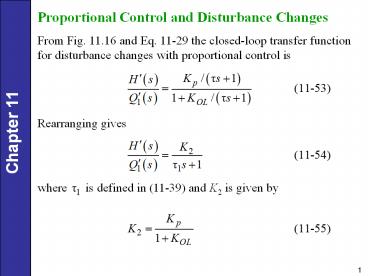Proportional Control and Disturbance Changes - PowerPoint PPT Presentation
Title:
Proportional Control and Disturbance Changes
Description:
11-29 the closed-loop transfer function for disturbance changes with proportional control is ... For a unit step change in disturbance, , and (11-59) becomes ... – PowerPoint PPT presentation
Number of Views:46
Avg rating:3.0/5.0
Title: Proportional Control and Disturbance Changes
1
Proportional Control and Disturbance Changes
From Fig. 11.16 and Eq. 11-29 the closed-loop
transfer function for disturbance changes with
proportional control is
Rearranging gives
where is defined in (11-39) and K2 is given
by
2
- A comparison of (11-54) and (11-37) indicates
that both closed-loop transfer functions are
first-order and have the same time constant. - However, the steady-state gains, K1 and K2, are
different. - From Eq. 11-54 it follows that the closed-loop
response to a step change in disturbance of
magnitude M is given by
The offset can be determined from Eq. 11-56. Now
since we are considering
disturbance changes and for a
step change of magnitude M. Thus,
3
Figure 11.19 Load responses for Example 11.3.
4
PI Control and Disturbance Changes
For PI control,
. The closed-loop transfer function for
disturbance changes can then be derived from Fig.
11.16
Clearing terms in the denominator gives
Further rearrangement allows the denominator to
be placed in the standard form for a second-order
transfer function
5
where
For a unit step change in disturbance,
, and (11-59) becomes
For , the response is a damped
oscillation that can be described by
6
(No Transcript)
7
PI Control of an Integrating Process
Consider the liquid-level control system shown in
Fig. 11.22. This system differs from the previous
example in two ways
- the exit line contains a pump and
- the manipulated variable is the exit flow rate
rather than an inlet flow rate.
In Section 5.3 we saw that a tank with a pump in
the exit stream can act as an integrator with
respect to flow rate changes because
8
Figure 11.22 Liquid-level control system with
pump in exit line.
9
If the level transmitter and control valve in Eq.
11.22 have negligible dynamics, the Gm(s) Km
and Gv(s) Kv. For PI control,
. Substituting these
expressions into the closed-loop transfer
function for disturbance changes
and rearranging gives
where
And KOL KcKvKpKm with Kp - 1/A.
10
Stability of Closed-Loop Control Systems
Example 11.4 Consider the feedback control system
shown in Fig. 11.8 with the following transfer
functions
Show that the closed-loop system produces
unstable responses if controller gain Kc is too
large.
11
Figure 11.23. Effect of controller gains on
closed-loop response to a unit step change in set
point (example 11.1).































